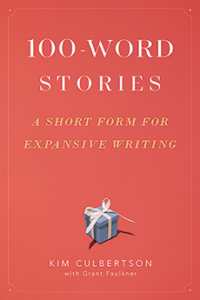By Kim Culbertson
 One of my favorite sounds in the world is the scratch of pens and pencils on paper. So when I found myself in an echoey middle school gym with the entirety of the school’s sixth grade (maybe 100+ students), this sound was even more delicious than my usual classroom.
One of my favorite sounds in the world is the scratch of pens and pencils on paper. So when I found myself in an echoey middle school gym with the entirety of the school’s sixth grade (maybe 100+ students), this sound was even more delicious than my usual classroom.
I had been invited to teach a workshop about the 100-word story form. After I went through my initial explanation about the form – that it’s exactly 100 words (not including the title!); that it has a clear beginning, middle, and end; that it forces us to make choices in our writing; that it includes all the elements of a longer story (character, setting, conflict, sensory details, arc, tone, etc.) – we launched into a generative writing exercise:
Choose a setting, the name of a character, and an object. Write these at the top of your paper. Now, create a 100-word story where because of that object, the character has something go wrong.
Immediate scratching (glorious!). I smiled as many of them started to count their words: tap, tap, tap. One boy raised his hand. “This seems like math,” he said, the kid next to him cracking up as if they were both at a stand-up comedy show and his friend was killing it.
“Fair enough,” I said. “Writing can be like math.”
Some of the scratching and tapping silenced. “How?” asked another girl, serious, and with one heck of an impressive pencil case on her lap. Because, I explained to the group, as writers we are always looking for places in our work to add and subtract things in order to amplify and understate things.
Some of them looked puzzled. “The most important thing right now,” I told them. “Is that you get a story on the page. You can worry about the word count later.” I didn’t want them to start with their editor brains. With a first draft, we were just getting our voices on the page.
What this is really about
Here’s the secret of this form: at the end of the day, it isn’t about the 100-word limit. It’s about having a boundary to push against. Don’t get me wrong: I love a good freewrite. But I also think it’s useful to have limits. To see what happens when we are given restrictions in our work.
What creative inspiration might come out of the need to cut two words? Or change the opening line? Or find a better way to describe something? This teaches young writers to access their inner editor, but also their inner inventor. It teaches them to pay close attention to their ideas and the way these ideas show up in their sentences.
This concept showed up in that gym full of sixth graders, and I left with a full heart. Some of them, their teachers told me later, hadn’t been that engaged with their writing all year.
This form is small, but it is mighty
Some of this might is because this form allows for the writing experience to be playful. When students have a draft or two under their belts, I sometimes ask them to choose one word in their piece that can be amplified, and I have them make a list of other possible words they might use.
Then I have them circle that word and write the list right in the margin of their journal. I encourage them to have fun with their list. Be extravagant with their options. If the word they circled is funny, maybe the margin list looks like hilarious, hysterical, uproarious, amusing.
Then I ask them to investigate the nuance of each of these words. They are similar, sure – but they are also different. How? And how does choosing one over the other change the nature of the story? What does it imply or showcase about your main character or the setting or the conflict?
Ultimately, we always return to voice. “Which word sounds most like you?” I ask them. This is, after all, the most important part of learning to write: that slow, deliberate understanding of what it means to share your ideas with the world in written form, with full awareness of your own choices and rhythms.
I teach high school seniors, and I often tell them that this is what I care about most: hearing you in the piece. That day in the gym full of six graders, I explained how special this journey of finding their own writing voices can be for them – if they let it. Even in this busy, buzzing world that seems so full of replications and distractions, there is still only one you, I told them. And that is a kind of magic. Magic you can share.
After that workshop a girl came up to me, shy and holding her story. “It’s more than 100 words,” she said, guiltily. “It’s okay,” I said. “Short form is all about revising and playing with your ideas. Keep working on it. Move things around. Cross things out and add others. See where the exploration of it takes you. The most important part is that you’re finding your own voice in this.” She promised to email it when she was ready. It doesn’t get much better than that.
In his introduction to my book 100-Word Stories: A Short Form for Expansive Writing, Grant Faulkner writes: “These stories might be small cells, but they teem with life when looked at under a microscope.” This kind of examination is the beauty of this practice for any age of writer, but especially for young writers – it teaches them to study their work in a close, personal way so they can grow the voices they will carry with them into their lives.
Image by COPPERTIST WU on Unsplash
 Kim Culbertson holds an M.S. in Education and an MFA in Fiction and has been teaching high school creative writing and English since 1997. She is the award-winning author of five YA novels. Her titles Catch a Falling Star, The Possibility of Now, and The Wonder of Us were Scholastic book club selections. She won the Northern California Book Award for YA fiction for Instructions for a Broken Heart as well as had The Possibility of Now named a Bank Street Best Book of the Year. Her first novel for adults, Other People’s Kids, is about (surprise, surprise) teachers.
Kim Culbertson holds an M.S. in Education and an MFA in Fiction and has been teaching high school creative writing and English since 1997. She is the award-winning author of five YA novels. Her titles Catch a Falling Star, The Possibility of Now, and The Wonder of Us were Scholastic book club selections. She won the Northern California Book Award for YA fiction for Instructions for a Broken Heart as well as had The Possibility of Now named a Bank Street Best Book of the Year. Her first novel for adults, Other People’s Kids, is about (surprise, surprise) teachers.
In addition to teaching high school, Kim sits on the Writers Council for National Writing Project and works as a fiction mentor with Dominican University of California’s MFA in Creative Writing. With 100-Word Stories: A Short Form for Expansive Writing, Kim has finally found a way to blend her two professional loves, teaching and writing, into one book. (Read a MiddleWeb review.) To find out more about her consulting work, visit her website here.


